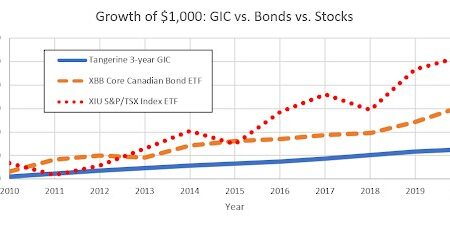RRSP Tip: Carry Forward Your RRSP Tax Deduction
With the RRSP deadline right around the corner (March 2, 2009), this is a strategy that I’ve mentioned in passing a couple times, but never in great detail. That is, providing that the situation is right, you should consider carrying forward all or a portion of your RRSP tax deduction to a future year to maximize your tax return.
Who should do this?
I can see this strategy being useful in two situations:
- Higher Income in the Future. Recent university graduates are a prime example. New job, lower starting salaries, but some built up RRSP contribution room over the past few years. With higher future earning potential, thus higher tax rates in the coming years, it may make sense to carry forward the RRSP tax deduction to be claimed during years of higher income (thus higher taxes). This will allow the new grad to start building their investment portfolio to take advantage of the time value of compounding growth and obtain a larger tax deduction in the years of higher earnings.
- Claim just enough to drop to the next bracket below. As you may know, RRSP contributions result in a tax deduction which means that they reduce your income (and taxes owed) for the year. However, since the Canadian tax system is progressive (the more you earn, the higher your tax rate), it may make sense to contribute just enough to lower your income to the next tax level below. That way, your current RRSP contributions can be used for the higher tax bracket next year. This works especially well if you expect to make more money in future years.
How Much Will I Save?
Say for example that Andrew, from NL, makes $42,885 / year with a $10k contribution for 2008. Looking up his marginal tax rate, the amount earned above $37,885 will face 35.3% tax. Amounts from $37,885 to $30,215 will face 28.3% tax.
If Andrew were to claim the whole RRSP contribution this year, it would result in a tax return of ($5,000×35.3%) + ($5,000×28.3%) = $3,130. However, if he were to carry forward $5,000, then he would get an extra $350 back on his contribution (or 7% more) on his $5,000.
The caveat being that you need to account for the time value of money before using this strategy. Basically, the tax savings from waiting a year should beat any potential gains you would have made by investing/saving the money. Another thing to note is that sometimes the spread between tax brackets is small which makes this strategy not as effective.
Final Thoughts
Although carrying forward your RRSP tax deduction may not be for everyone, it works great for those who have a large RRSP contribution and would end up dropping down a significant tax bracket if the total contribution was claim in that year. It also works well in reverse. That is, if you expect to jump tax brackets due to increased income in future years.
As I mentioned above, if you only end up saving a couple percentage points, then it may not be worth your while to carry your tax deduction forward. You’ll have to decide for yourself whether or not your situation warrants carrying forward the RRSP tax deduction.
Do you use a similar strategy? Or do you simply claim your whole RRSP contribution every year?
As always, this post is for informational purposes only. Please consult a financial and/or tax professional before implementing any strategies mentioned on this blog.










Hello
I have some questions regarding RRSP, I never contribute before and a bit confused.
For example if I make 46K per year and I receive $1.400 biweekly on my paycheque.
– What is my taxable income? Is it 46,000 or the net (1.400×24= $33,600)?
– What about dividend and interest from the bank, does it count toward my taxable income?
– Is my RRSP contribution room 18%x46,000 or 18%x(46,000+dividend/interest) or 18%x33,600?
– If I have contribution room of $10.000, can I contribute all to my RRSP account at one time and make a split deduction? For example for 2016 tax year I will deduct 3,000 and for next year I will deduct the 7,000?
Thank you
Hi Jess,
To start, with your income, have you considered contributing to a TFSA instead? But to answer your questions:
1. Your RRSP contribution would reduce your taxable income for the year.
2. Dividends and interest are taxable in a non-registered account (ie. not taxable in RRSP/TFSA), but at a different rate than regular income.
3. Best way to get an accurate RRSP contribution room is via your notice of assessment that you receive every year. But generally, it’s 18%xyour earned income (not investment income).
4. Yes, you can claim some this year, and carry forward some as well. If you expect higher income in future years, you might want to consider carrying forward some of your deduction.
Thank you for your reply.
I think I understand now the difference between taxable income and earned income. I have max out my TFSA so that’s why I’m looking to invest some in RRSP.
I’m planning to invest in some US stocks and ETF in my RRSP account using Questrade. I will transfer US money directly (not doing currency exchange) from my bank account to Questrade using direct deposit. When it comes to the tax season, is Questrade will automatically doing the currency exchange for my RRSP contribution? Or I have to do it approximately using National Bank currency exchange?
Jess, I don’t have experience with depositing USD into an RRSP. I would assume that they would take the spot rate on the day of deposit and convert it to CAD for your tax receipt. Might be something to ping Questrade support about.
For the sake of future readers looking for an answer to Remus’ question about the official aspects of this: See Schedule 7, i.e., T1 General 2012 – Schedule 7 – RRSP Unused Contributions… it distinguishes between the Contribution (Part A) and the deduction (Part C), giving rise to the unused contribution to carry-forward (Part D).
I think this strategy almost never makes sense if you’ve planned your taxes appropriately.
If you are going to be in a higher tax bracket and want to claim later then invest later and claim when you invest. Instead of putting the money in your RRSP you should put it in a normal trading account – take advantage of the capital gain tax rate that saves you 50% as well as the potential capital loss rule – and then just pay the tax and move it into your RRSP when you need the deduction or continue deferring the captial gain and instead invest new cash into your rrsp.
You can always know what your tax bracket is before putting money into your RRSP since you can put January,February contributions from say 2013 into the 2012 taxes which you should be able to calculate exactly in 2013. With that in mind you’d always just contribute exactly what you needed to bring you down the tax bracket and again invest what you don’t need outside in a normal capital gains advantaged account.
The only exception I can think of is that your company matches RRSP contribution and this effectively forces you to contribute to the RRSP. In this case it could make sense to defer the claim until you are in the next tax bracket. Still you are losing interest on the refund that would normally come from claiming this money so depending on your debt load you may be paying more in interest expenses than you’d be saving on the next tax bracket margin. If you have no debt then the equation gets trickier as interest rates are so low right now.
Leanne:
Yes, RSP contribution room carries forward indefinitely.
Re: the homebuyers program, your RRSP contributions must remain in the RRSP for at least 90 days before you can withdraw them under the HBP, or they may not be deductible for any year. Not sure how quickly you are looking to buy, but that is something important to keep in mind.
Also, don’t forget you can only withdraw $25,000 per person for the Homebuyers Program so if you have more than that to invest, you will want to both open up an RSP.
http://www.cra-arc.gc.ca/tx/ndvdls/tpcs/rrsp-reer/hbp-rap/menu-eng.html
My husband and I have not used any of our RRSP room to date. We are currently 24 and plan on making a huge lump sum into our RRSP’s for the 2010 tax year then withdraw for the 1st time home buyers plan. This way my husband’s income will be taxed at the lowest rate and we can also get a large tax return! I’m thinking new furniture for the new house and an emergency savings account. I am just researching how long you can carry forward unused RRSP contribution amounts, haven’t found an answer yet, but I assume it is indefinite?
Hi aooa,
You have not mentioned your income amounts. Carrying forward your RRSP contributions will not save you money, unless it would bring you to a lower tax bracket this year.
Also, the optimum RRSP contribution is not the amount that means you don’t pay tax when you file your return. Many people look at whether they have to pay at tax time, but that is not the important issue.
The optimum RRSP contribution is the amount that will bring you to the bottom of you current tax bracket, but only if you can deduct it at a higher tax bracket in a future year.
Ed
Hi Remus,
If you want to prove this to your accountant, look at the bottom of your Notice of Assessment in the RRSP contibution room section. The very bottom number is the amount of RRSP contibutions not deducted and carried forward. If you accountant doubts this works, why does CRA have field to track the amount you carry forward?
Ed
Hi FT,
Good post. This is one of the 3 Ds of tax savings – deduct, defer, divide. We use this strategy a lot with our clients – not just with RRSP contributions, but with other deductions or credits. It is useful to know what tax bracket you are in and how far your income is from the next higher or lower tax bracket.
Ed
Hi! Great tip. I use this strategy frequently (being self employed). One question..is there a time limit on how many years you can carry this forward? Thanks!
Just a follow up to aooa’s post.
I took a look at the Ontario Health Premiums, specifically the $72,000 to 72,600 bracket premiums ($600/year -> $750/year).
If one had the contribution room and was somewhat above the $72,600 mark, there could be a definite savings.
http://www.rev.gov.on.ca/english/taxes/healthpremium/rates.html